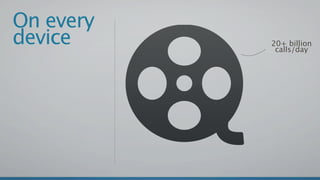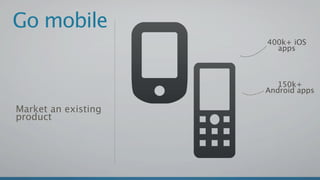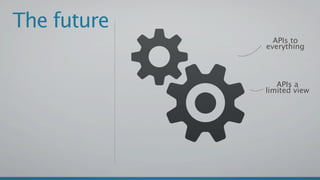Ad
Why APIs are important
- 1. Why are APIs 1 7 important? JUNI 2011 PRESENTED BY ANDREAS KROHN
- 3. Andreas Krohn @andreaskrohn mashup.se
- 4. Andreas Krohn @andreaskrohn [email protected] mashup.se
- 5. Agenda
- 6. Agenda 1 WHAT DO I MEAN BY “API”?
- 7. Agenda 1 WHAT DO I MEAN BY “API”? 2 SUCCESS STORIES
- 8. Agenda 1 WHAT DO I MEAN BY “API”? 2 SUCCESS STORIES 3 TOP 3 REASONS WHY APIs ARE IMPORTANT
- 9. Agenda 1 WHAT DO I MEAN BY “API”? 2 SUCCESS STORIES 3 TOP 3 REASONS WHY APIs ARE IMPORTANT 4 DO YOU NEED AN API?
- 10. What do I mean by API?
- 11. What do I mean by API? API
- 12. What do I mean by API? API Web
- 13. What do I Open mean by API? API Web
- 14. What do I Open mean by API? API Web Loosely coupled
- 15. What do I Open mean by API? API Ecosystem Web Loosely coupled
- 16. Be the Platform
- 17. Be the Platform 13 billion calls/day
- 18. Be the Platform 13 billion calls/day 80+ APIs based on Twitter
- 19. Be the Platform 13 billion calls/day 80+ APIs based on Twitter Not owning the experience
- 20. On every device
- 21. On every device 20+ billion calls/day
- 22. On every device 20+ billion calls/day Partners & Internal
- 23. Owning Identity
- 24. Owning Identity 5 billion calls/day (2009)
- 25. Owning Identity 5 billion calls/day (2009) FB Connect
- 26. Owning Identity 5 billion calls/day (2009) FB Connect Like
- 27. Local Examples
- 28. Local Examples
- 29. Local Examples
- 30. Local Examples
- 32. Why are APIs important?
- 35. Promotion Your brand everywhere Market an existing product
- 36. Promotion Your brand everywhere Create traffic for other properties Market an existing product
- 37. Promotion Your brand everywhere Create traffic for other properties Market an existing product Become the standard
- 39. Reach new markets New countries Market an existing product
- 40. Reach new markets New countries New languages Market an existing product
- 41. Reach new markets New countries New languages Market an existing product New niches
- 42. Go mobile Market an existing product
- 43. Go mobile 400k+ iOS apps Market an existing product
- 44. Go mobile 400k+ iOS apps 150k+ Android apps Market an existing product
- 45. Go mobile 400k+ iOS apps 150k+ Android apps Market an existing product APIs are the key to mobile apps
- 46. MARKET SELL an existing product as a new product
- 47. Cash is fun Sell as a new product
- 48. Cash is fun Sell API access Sell as a new product
- 49. Cash is fun Sell API access Sell as a new Indirect income product
- 50. MARKET SELL USE an existing product as a new product as infrastructure component
- 52. ROA Interoperability Use as component
- 53. ROA Interoperability Weak coupling Use as component
- 54. ROA Interoperability Weak coupling Use as component Quicker and easier to use
- 56. Internal Decouple systems Use as component
- 57. Internal Decouple systems APIs first Use as component
- 58. Internal Decouple systems APIs first Use as component Save time using APIs
- 59. MARKET SELL USE an existing product as a new product as infrastructure component
- 61. Do you need an 1 INNOVATION ALWAYS ORGANIZATION BIGGER OUTSIDE THE API?
- 62. Do you need an 1 INNOVATION ALWAYS ORGANIZATION BIGGER OUTSIDE THE API? 2 TURN COMPETITORS INTO PARTNERS
- 63. Do you need an 1 INNOVATION ALWAYS ORGANIZATION BIGGER OUTSIDE THE API? 2 TURN COMPETITORS INTO PARTNERS 3 NOT HAVING AN API GIVES ALL THE ADVANTAGES TO YOUR COMPETITORS
- 64. Do you need an 1 INNOVATION ALWAYS ORGANIZATION BIGGER OUTSIDE THE API? 2 TURN COMPETITORS INTO PARTNERS 3 NOT HAVING AN API GIVES ALL THE ADVANTAGES TO YOUR COMPETITORS 4 LEGISLATION
- 65. The future
- 66. The future APIs to everything
- 67. The future APIs to everything APIs a limited view
- 68. The future APIs to everything APIs a limited view Full data access
- 69. QA [email protected] & @andreaskrohn mashup.se THANK YOU!
Editor's Notes
- #2: It should be enough that APIs are cool, but I will give you reasons that your bosses and colleagues will listen to \n
- #3: \n
- #4: \n
- #5: 3. Two business reasons and, finally, one technical reason\n
- #6: 3. Two business reasons and, finally, one technical reason\n
- #7: 3. Two business reasons and, finally, one technical reason\n
- #8: 3. Two business reasons and, finally, one technical reason\n
- #9: 3. Two business reasons and, finally, one technical reason\n
- #10: 3. Two business reasons and, finally, one technical reason\n
- #11: 3. Two business reasons and, finally, one technical reason\n
- #12: 3. Two business reasons and, finally, one technical reason\n
- #13: All programming languages are APIs, almost everyone in this room work with APIs all day strictly speaking\nAlso SOAP WebServices and system integrations solutions\nThis means REST, JSON, XML\n
- #14: All programming languages are APIs, almost everyone in this room work with APIs all day strictly speaking\nAlso SOAP WebServices and system integrations solutions\nThis means REST, JSON, XML\n
- #15: All programming languages are APIs, almost everyone in this room work with APIs all day strictly speaking\nAlso SOAP WebServices and system integrations solutions\nThis means REST, JSON, XML\n
- #16: All programming languages are APIs, almost everyone in this room work with APIs all day strictly speaking\nAlso SOAP WebServices and system integrations solutions\nThis means REST, JSON, XML\n
- #17: All programming languages are APIs, almost everyone in this room work with APIs all day strictly speaking\nAlso SOAP WebServices and system integrations solutions\nThis means REST, JSON, XML\n
- #18: All programming languages are APIs, almost everyone in this room work with APIs all day strictly speaking\nAlso SOAP WebServices and system integrations solutions\nThis means REST, JSON, XML\n
- #19: All programming languages are APIs, almost everyone in this room work with APIs all day strictly speaking\nAlso SOAP WebServices and system integrations solutions\nThis means REST, JSON, XML\n
- #20: All programming languages are APIs, almost everyone in this room work with APIs all day strictly speaking\nAlso SOAP WebServices and system integrations solutions\nThis means REST, JSON, XML\n
- #21: All programming languages are APIs, almost everyone in this room work with APIs all day strictly speaking\nAlso SOAP WebServices and system integrations solutions\nThis means REST, JSON, XML\n
- #22: All programming languages are APIs, almost everyone in this room work with APIs all day strictly speaking\nAlso SOAP WebServices and system integrations solutions\nThis means REST, JSON, XML\n
- #23: All programming languages are APIs, almost everyone in this room work with APIs all day strictly speaking\nAlso SOAP WebServices and system integrations solutions\nThis means REST, JSON, XML\n
- #24: All programming languages are APIs, almost everyone in this room work with APIs all day strictly speaking\nAlso SOAP WebServices and system integrations solutions\nThis means REST, JSON, XML\n
- #25: All programming languages are APIs, almost everyone in this room work with APIs all day strictly speaking\nAlso SOAP WebServices and system integrations solutions\nThis means REST, JSON, XML\n
- #26: Started with API as an afterthought, Constantly improved, Are now going to be basically part of iOS 5\nOver a year ago (2010-04-15) 75% of traffic from API on 3 billion calls/day\nProblem of not owning the experience, desperately looking for a business model\nSidenote: twitter is a great example of how to document an API and a great place to start if you want to experiment with APIs\n\nhttp://blog.programmableweb.com/2010/04/15/twitter-reveals-75-of-our-traffic-is-via-api-3-billion-calls-per-day/\n
- #27: Started with API as an afterthought, Constantly improved, Are now going to be basically part of iOS 5\nOver a year ago (2010-04-15) 75% of traffic from API on 3 billion calls/day\nProblem of not owning the experience, desperately looking for a business model\nSidenote: twitter is a great example of how to document an API and a great place to start if you want to experiment with APIs\n\nhttp://blog.programmableweb.com/2010/04/15/twitter-reveals-75-of-our-traffic-is-via-api-3-billion-calls-per-day/\n
- #28: Started with API as an afterthought, Constantly improved, Are now going to be basically part of iOS 5\nOver a year ago (2010-04-15) 75% of traffic from API on 3 billion calls/day\nProblem of not owning the experience, desperately looking for a business model\nSidenote: twitter is a great example of how to document an API and a great place to start if you want to experiment with APIs\n\nhttp://blog.programmableweb.com/2010/04/15/twitter-reveals-75-of-our-traffic-is-via-api-3-billion-calls-per-day/\n
- #29: Started with API as an afterthought, Constantly improved, Are now going to be basically part of iOS 5\nOver a year ago (2010-04-15) 75% of traffic from API on 3 billion calls/day\nProblem of not owning the experience, desperately looking for a business model\nSidenote: twitter is a great example of how to document an API and a great place to start if you want to experiment with APIs\n\nhttp://blog.programmableweb.com/2010/04/15/twitter-reveals-75-of-our-traffic-is-via-api-3-billion-calls-per-day/\n
- #30: Started with API as an afterthought, Constantly improved, Are now going to be basically part of iOS 5\nOver a year ago (2010-04-15) 75% of traffic from API on 3 billion calls/day\nProblem of not owning the experience, desperately looking for a business model\nSidenote: twitter is a great example of how to document an API and a great place to start if you want to experiment with APIs\n\nhttp://blog.programmableweb.com/2010/04/15/twitter-reveals-75-of-our-traffic-is-via-api-3-billion-calls-per-day/\n
- #31: Started with API as an afterthought, Constantly improved, Are now going to be basically part of iOS 5\nOver a year ago (2010-04-15) 75% of traffic from API on 3 billion calls/day\nProblem of not owning the experience, desperately looking for a business model\nSidenote: twitter is a great example of how to document an API and a great place to start if you want to experiment with APIs\n\nhttp://blog.programmableweb.com/2010/04/15/twitter-reveals-75-of-our-traffic-is-via-api-3-billion-calls-per-day/\n
- #32: Netflix, Largest source of internet traffic in North America, over 22% of all traffic\n18k developers = 0.5% of API traffic\n99.5% of API traffic from device manufacturers and internal Netflix use\n\nhttp://blog.programmableweb.com/2011/03/29/netflix-api-now-serving-20-billion-requests-per-month\nhttp://www.engadget.com/2011/05/17/study-finds-netflix-is-the-largest-source-of-internet-traffic-in/\nhttp://blog.apievangelist.com/2011/06/10/lessons-in-api-deployment-from-netflix/\n
- #33: Netflix, Largest source of internet traffic in North America, over 22% of all traffic\n18k developers = 0.5% of API traffic\n99.5% of API traffic from device manufacturers and internal Netflix use\n\nhttp://blog.programmableweb.com/2011/03/29/netflix-api-now-serving-20-billion-requests-per-month\nhttp://www.engadget.com/2011/05/17/study-finds-netflix-is-the-largest-source-of-internet-traffic-in/\nhttp://blog.apievangelist.com/2011/06/10/lessons-in-api-deployment-from-netflix/\n
- #34: Netflix, Largest source of internet traffic in North America, over 22% of all traffic\n18k developers = 0.5% of API traffic\n99.5% of API traffic from device manufacturers and internal Netflix use\n\nhttp://blog.programmableweb.com/2011/03/29/netflix-api-now-serving-20-billion-requests-per-month\nhttp://www.engadget.com/2011/05/17/study-finds-netflix-is-the-largest-source-of-internet-traffic-in/\nhttp://blog.apievangelist.com/2011/06/10/lessons-in-api-deployment-from-netflix/\n
- #35: Netflix, Largest source of internet traffic in North America, over 22% of all traffic\n18k developers = 0.5% of API traffic\n99.5% of API traffic from device manufacturers and internal Netflix use\n\nhttp://blog.programmableweb.com/2011/03/29/netflix-api-now-serving-20-billion-requests-per-month\nhttp://www.engadget.com/2011/05/17/study-finds-netflix-is-the-largest-source-of-internet-traffic-in/\nhttp://blog.apievangelist.com/2011/06/10/lessons-in-api-deployment-from-netflix/\n
- #36: 5 billion calls/day is an old number, october 2009\nUsing the API to make FB the default identity platform on the web\nOpen Graph API\n\nhttp://blog.programmableweb.com/2010/04/15/twitter-reveals-75-of-our-traffic-is-via-api-3-billion-calls-per-day/\n
- #37: 5 billion calls/day is an old number, october 2009\nUsing the API to make FB the default identity platform on the web\nOpen Graph API\n\nhttp://blog.programmableweb.com/2010/04/15/twitter-reveals-75-of-our-traffic-is-via-api-3-billion-calls-per-day/\n
- #38: 5 billion calls/day is an old number, october 2009\nUsing the API to make FB the default identity platform on the web\nOpen Graph API\n\nhttp://blog.programmableweb.com/2010/04/15/twitter-reveals-75-of-our-traffic-is-via-api-3-billion-calls-per-day/\n
- #39: 5 billion calls/day is an old number, october 2009\nUsing the API to make FB the default identity platform on the web\nOpen Graph API\n\nhttp://blog.programmableweb.com/2010/04/15/twitter-reveals-75-of-our-traffic-is-via-api-3-billion-calls-per-day/\n
- #40: 5 billion calls/day is an old number, october 2009\nUsing the API to make FB the default identity platform on the web\nOpen Graph API\n\nhttp://blog.programmableweb.com/2010/04/15/twitter-reveals-75-of-our-traffic-is-via-api-3-billion-calls-per-day/\n
- #41: 5 billion calls/day is an old number, october 2009\nUsing the API to make FB the default identity platform on the web\nOpen Graph API\n\nhttp://blog.programmableweb.com/2010/04/15/twitter-reveals-75-of-our-traffic-is-via-api-3-billion-calls-per-day/\n
- #42: \n
- #43: \n
- #44: \n
- #45: \n
- #46: saplo\npodio\nopenaid - joint venture between SIDA and UD\nSwedish International Development Agency + Swedish State Department\n
- #47: saplo\npodio\nopenaid - joint venture between SIDA and UD\nSwedish International Development Agency + Swedish State Department\n
- #48: saplo\npodio\nopenaid - joint venture between SIDA and UD\nSwedish International Development Agency + Swedish State Department\n
- #49: APIs are a tool to use to reach your goals\n3 main reasons why APIs are important\n
- #50: \n
- #51: Creating traffic, if your API is not the product it could create traffic - Booli API\nNetflix is the movie standard in the US, FB/Twitter are the social media standard \n
- #52: Creating traffic, if your API is not the product it could create traffic - Booli API\nNetflix is the movie standard in the US, FB/Twitter are the social media standard \n
- #53: Creating traffic, if your API is not the product it could create traffic - Booli API\nNetflix is the movie standard in the US, FB/Twitter are the social media standard \n
- #54: Creating traffic, if your API is not the product it could create traffic - Booli API\nNetflix is the movie standard in the US, FB/Twitter are the social media standard \n
- #55: Creating traffic, if your API is not the product it could create traffic - Booli API\nNetflix is the movie standard in the US, FB/Twitter are the social media standard \n
- #56: Creating traffic, if your API is not the product it could create traffic - Booli API\nNetflix is the movie standard in the US, FB/Twitter are the social media standard \n
- #57: New markets without further investment\nInvoicing system in one niche -> general invoicing system\n
- #58: New markets without further investment\nInvoicing system in one niche -> general invoicing system\n
- #59: New markets without further investment\nInvoicing system in one niche -> general invoicing system\n
- #60: New markets without further investment\nInvoicing system in one niche -> general invoicing system\n
- #61: New markets without further investment\nInvoicing system in one niche -> general invoicing system\n
- #62: New markets without further investment\nInvoicing system in one niche -> general invoicing system\n
- #63: \n
- #64: \n
- #65: \n
- #66: \n
- #67: \n
- #68: \n
- #69: \n
- #70: Profit Sharing\nCreate indirect income, ie customers must have a payed account for the developers to use the API for that user\n
- #71: Profit Sharing\nCreate indirect income, ie customers must have a payed account for the developers to use the API for that user\n
- #72: Profit Sharing\nCreate indirect income, ie customers must have a payed account for the developers to use the API for that user\n
- #73: Profit Sharing\nCreate indirect income, ie customers must have a payed account for the developers to use the API for that user\n
- #74: \n
- #75: Almost “SOA”\n
- #76: Almost “SOA”\n
- #77: Almost “SOA”\n
- #78: Almost “SOA”\n
- #79: Almost “SOA”\n
- #80: Almost “SOA”\n
- #81: Base your own website in your API\nInstagram - internal API, hacked API, public API\nInstagram & picplz API competitors\n
- #82: Base your own website in your API\nInstagram - internal API, hacked API, public API\nInstagram & picplz API competitors\n
- #83: Base your own website in your API\nInstagram - internal API, hacked API, public API\nInstagram & picplz API competitors\n
- #84: Base your own website in your API\nInstagram - internal API, hacked API, public API\nInstagram & picplz API competitors\n
- #85: Base your own website in your API\nInstagram - internal API, hacked API, public API\nInstagram & picplz API competitors\n
- #86: Base your own website in your API\nInstagram - internal API, hacked API, public API\nInstagram & picplz API competitors\n
- #87: \n
- #88: \n
- #89: \n
- #90: \n
- #91: \n
- #92: \n
- #93: \n
- #94: \n
- #95: \n
- #96: \n
- #97: \n
- #98: \n
- #99: \n
- #100: \n
- #101: \n
- #102: \n












































































































































